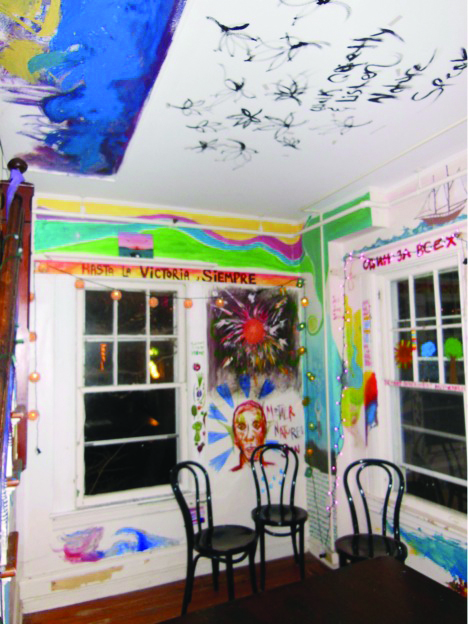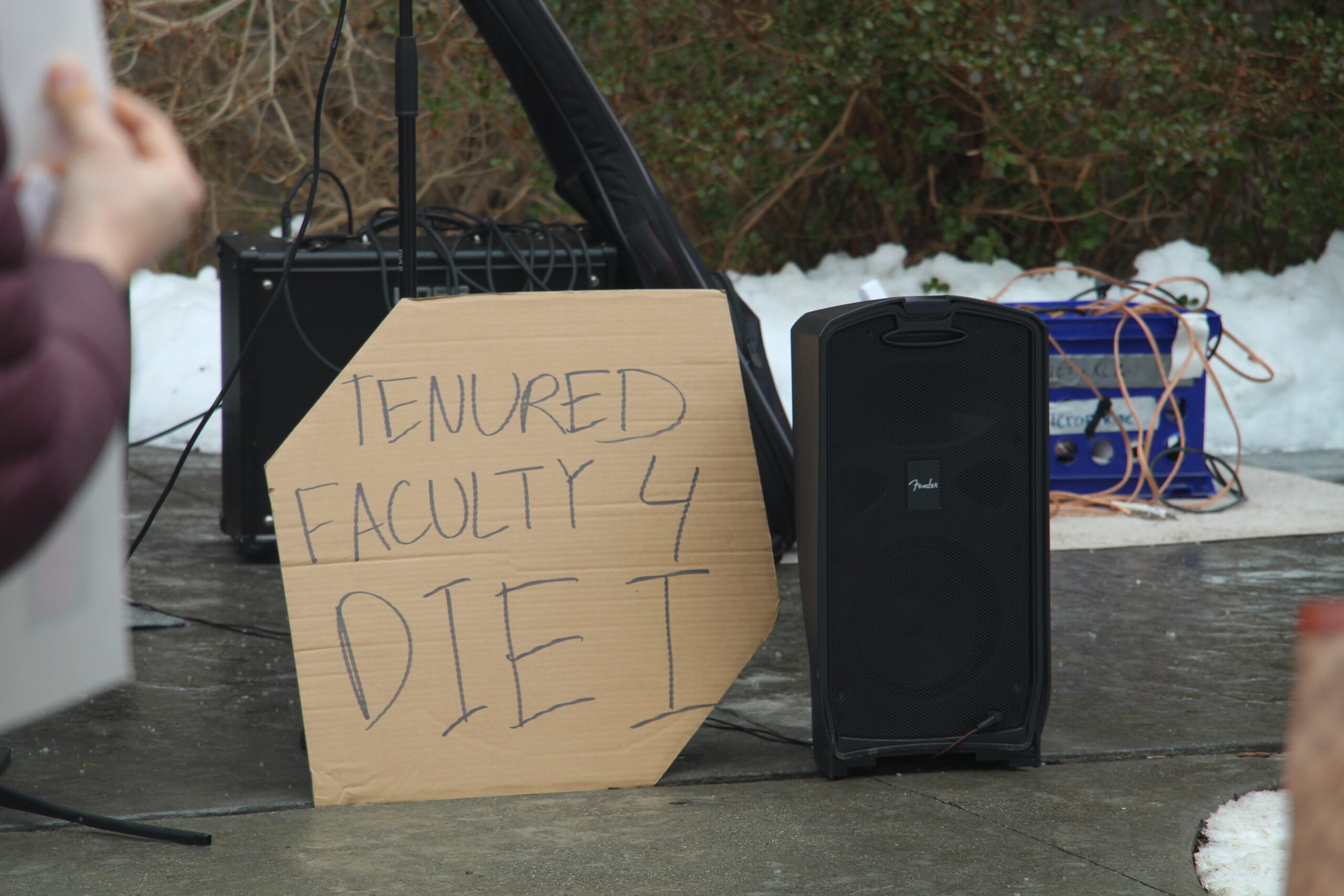Last spring, Liz de Lise ’13 published an article in The College Voice entitled “Whitewashing Tradition”, documenting the Office of Residential Life & Education’s (REAL) plan to paint over the colorful walls of the Earth House kitchen and living room, and the resulting disappointment shared by the house’s residents and their supporters in response to the proposed changes. After a lengthy petition process and outrage from the student body, REAL retracted their plans, allowing the murals to continue to provide Earth House residents with sentiments of past legacy and tradition, a shared history and collective memory. This, a solid, laudable and, most importantly, successful attempt by the student body to engage in the process of self-governance, is representative of the college community’s ability to organize itself to fight injustice on this campus.
Doesn’t it always seem that when one battle is won, another looms on the horizon? This would seem to be the case here, while REAL prepares to implement new changes in its process for determining independent living options. On Tuesday, 3 December, REAL called a meeting with the seven residents of Earth House, myself included, to inform us of changes being made in each of the independent living situations, set to be enacted in time for the 2014-2015 academic year. All decisions, of course, were final, and just like the infamous Fishbowl verdict of 2012, we students were merely being advised of changes a bit ahead of time; we were not consulted, not asked for input, feedback, criticism, or suggestions—just advised.
What they told us is that all current independent living options will, by next year, require a theme, mission statement and faculty or staff adviser. Groups consisting of between three and twenty students can apply to live in any of the current independent living options (River Ridge apartments, Winchester houses, College owned houses on Mohegan Ave., the 360 Apartments and North Cottage House, currently known as Earth House) or a corridor of a residence hall. The REAL staff will place the groups of students who apply for independent housing depending on the quality of their theme, which they will determine by mandating that groups of students present to a panel of staff and student representatives affiliated with the REAL office.
Within the confines of this new process, the soon to be former Earth House could be inhabited by a group of seven students who prioritize environmentally-friendly living, as is the current situation, but it could also be assigned to members of a club sport, a particular major or any common interest that could theoretically provide engaging events and programming for the greater campus community. If one particular theme proves to be a successful, the group propagating that theme could inhabit the same apartment or house for consecutive academic years. As students in that independent living arrangement graduate, it would be up to the other underclassmen already living in that particular space to decide who is allowed to enter their community as a new member.
While this process could be interpreted as giving students greater agency to decide with whom they would like to live, it is also extremely exclusive and could quickly create cliques, so-called “in-groups” and “out-groups,” not dissimilar to the ways in which fraternities and sororities at other institutions operate and control their membership. Azul Tellez ’15, a resident of Earth House, says that what makes it special is in direct opposition with proposed changes. She believes that, “while college is about strengthening the friendships you already have, it is also very much about bonding with new people. Most of this bonding occurs over the food we cook together or simply sitting around the breakfast table. There’s something really extraordinary about moving into a house with people that you hardly know (for the most part) and getting to know them as the year goes on.”
The REAL staff continues to insist that the office has no desire to dispose of Earth House. Their actions, however, tell a very different tale. With this new independent living policy, they are actively undermining one of the goals of Connecticut College as dictated in the school’s mission statement: that of environmental stewardship. Yes, this mission statement does also contain five other goals, some of which remain unutilized in current thematic and independent housing, but greater diversification (which to be quite frank, cannot even be definitively guaranteed by the new independent living process) should not compromise tradition that has existed for many years at this institution. By refusing to guarantee Conn students a housing option that promotes and fosters environmentally-friendly living, the REAL office is trivializing the good work of students, faculty, staff and the administration, both past and present, to advance environmental sustainability at this institution. Earth House, its students and the faculty and staff who have supported and mentored them have played no small part in past dreams and desires being brought to fruition.
What will be lost with the elimination of Earth House? I can think of several things, the first of which being the community, which current resident Anna Curtis-Heald ’15 sums up by saying, “The house has one rule: give more than you take. ‘Love the house and it will love you,’ is painted on the wall by an anonymous former resident. The house sustains the community.”
The community Earth House creates on the Connecticut College campus is unparalleled. It is the only independent living option currently in place which allows seven strangers, who share a passion for environmentally-friendly living, to forge bonds with one another in ways otherwise impossible within the structure of Conn’s residence hall and independent living options. Earth House has not ever been perfect, but its sentiments and convictions are noteworthy additions to the Conn community. Casey Dillon ’14 sees the impending elimination of Earth House as just another part of a greater trend at the College. Dillon notes, “Ever since my freshman year, I’ve felt like the administration has been making changes and putting programs in place that are limiting self-expression and changing campus culture for the worse.”
We, as residents of the house, share meals cooked together in the kitchen and enjoy the feeling of shared history which comes alive in the colorfully painted walls and the furniture and dishware passed on from one generation of Earth House residents to the next. Curtis-Heald elaborated on her own experience, saying: “All members of the house had a moment when they realized, upon visiting it during their freshman or sophomore year, that they would like to live here one day, and we cherish offering the same glimpses and opportunities to younger students now by opening the house for events”.
There is, indeed, a comfort in knowing that this option for environmentally friendly living has existed for years, and that countless students committed to the environment have occupied the physical space of North Campus’s small, brown cottage. Lana Richards ’17 commented, “Earth House was one of the major reasons I decided to attend Conn in the first place.” The question that must now be posed is: Will Lana and other students who share similar convictions be afforded the opportunity to live there?
If the REAL office has an issue with the way in which we as Earth House residents are presently fulfilling our supposed purposes as members of Conn’s environmentally-friendly house, then I would highly suggest that the office’s staff approach us to inform us of that displeasure instead of taking the drastic step of eliminating the future guarantee of earth-friendly living. The REAL office has not once been in contact with us to inform us of their expectations or any responsibilities we should be fulfilling; our only contact with REAL has been through routine communications from our Housefellow, who has never been anything short of supportive of the events we put on and the way in which we live. We feel blindsided and saddened by REAL’s attempt to erase a Connecticut College tradition.
So, too, does this disappointment extend to Joyce and Jim Luce, administrative assistant in the Dean’s office and supervisor of grounds respectively, who for at least a decade, have acted as a second set of parents for Earth House residents, and have joined us for meals in the living room and invied us into their home and on many other excursions, and generously gave of time, care and concern I have not personally felt anywhere else on this campus. What will come of their contributions and connection with Earth House with the proposed changes?
In the Dec. 3 meeting, REAL staff continued to ask Earth House residents if we were scared or angry about their changes to what they are asking us to accept as the former Earth House. These changes, with their complete lack of regard for tradition, for environmental sustainability and unique, egalitarian community, threaten to erase a physical space that is so dear to me, those with whom l live, those who have previously lived there and all students, faculty and staff who have supported us. So, yes, REAL staff, I am scared, and I am angry. I do not agree with your refusal to engage in shared governance. I reject your argument that these changes in housing policies will unequivocally improve our campus community because Connecticut College is in danger of losing a diamond in the rough, a small house which has a character and a community simply unmatched by any other building on this campus. I can promise that Earth House will not be eliminated without valiant resistance. Please, any student, faculty or staff member who cares: join us to save Earth House. •











To anyone who would like to join our resistance, please e-mail me at zlarock@conncoll.edu !
To whom this may concern,
I have read the article and it is very heartbreaking. There is indeed a lot of misunderstanding between the students and the REAL staff. Not to mention an inequality in having a voice, on all sides.
If I haven’t had this opportunity to live in Erf Haus, as we all affectionately called Earth House, I would have never met my key role models, Jim Luce, Director of Grounds and Joyce Luce nor would I have met passionate activists who encouraged me to become one myself. I would have never appreciated the works of on ground staff members as well. Earth House has also motivated me to go into the plant field instead of an anthrocentric field for my career and paved the way to ending up into my favorite job, at the Conn College Arboretum.
What the housing office does not understand is that it will take away a legacy, one in which the current members become close to previous members, through Earth House, as previous members were a part of the selection process in the housing application. This is an excellent way to link alums who have lived in Earth House, with current residents, through the same sets of passions and I know Conn College is striving to connect alums with current students. Additionally, it is here at Earth House, that the majority of Conn gathers together owing to its sense of community and for the many events such as the Diner Night, and Earth House has always welcomed diversity and all groups to come and participate.
Right now, it seems like we do not have a voice here, but if the entire community stands for what it believes, as students pay $60K per year to attend Conn and faculty/staff are also involved in this, we have the right to have a say in this. It is so shameful that here at Colorado State University, where the tuition is 1/4 of Conn’s, and students have an active voice here- changes are made every day because of that, while at Conn, many of us go into debt and we don’t have a say in an issue such as this. From my understanding, Conn wishes to be a more sustainably focused, and I believe that through preserving Earth House as it is, instead of stripping it of all of its history, including opening it up to sport clubs and other groups who will never comprehend the history that makes up Earth House, will add to an already growing group of environmentally conscious members who make it their main aim in life to fight and conserve the environment through farming and clean energy incentives. This is because of the ongoing sense of community passed down from the previous members to the current members over the last decade or two. By placing groups that still have “sustainable incentives” but have other themes as well, makes this not sustainable anymore, but rather, green-washing because “sustainability” is at the center of the focus of the current Earth House, it is the ONE theme that all of us bond over at Earth House, and we Earth House members actively commit to sustainability, every minute, every hour, every day, every week, every month we are there. These groups will not be able to achieve the said commitment that Earth House requires. So, I repeat: Sustainability is the ONE theme that all of Earth House members, both past and present, bond over, breathing sustainability every moment that we live, inside the house and outside and afterwards.
Additionally, Earth House, as I have remembered it, again, was one of the biggest hotspots for environmental activists and people who want to learn more, to come and gather together over shared meals, not just the residents but also the College community. Again, I am repeating that Earth House, when I was there, has invited and embraced diversity of all kinds and encouraged community development through gatherings that focused on sustainability every single year, the types of events always change year to year but not the theme. With the REAL’s proposal to alter Earth House, it will merely become like 360 and Winchester houses, which are already very isolated and not really a part of the Conn College community. If Connecticut College strives to keep the authenticity of “sustainability” and not fall “victim” or not become a promoter of “green-washing”, as well as promoting a sense of community, I firmly believe that through keeping Earth House as it is, keeping the application the way it has always been, these two purposes can be achieved.
And all of this is a shame. I cannot give back to Connecticut College if we do not have a voice in this. The Office of Alumni Relations have had to come up with more creative ways to recruit alumni support, and it is getting harder and harder because we didn’t have as much of a voice while we were students at Conn and future students will have no voice at all. And we speak volumes as our money goes where our mouths are.
Please do not hesitate to contact me at aakearne@rams.colostate.edu if you have any questions or comments about my response to this article.
Best Regards,
Anne A. Kearney
Connecticut College Class of 2012
If any alum are interested in joining this effort, I recommend sending a hardcopy typewritten letter to REAL and CCing the Director of College Advancement and the Office of the President. Students:please email me at efisher2@conncoll.edu if there is anything else I can do to help!
Zach- Thank you for writing this and helping to continue the visibility of this resistance. REAL is attempting to forcibly change the culture of the Conn. You can’t force culture to change. They want to Conn to be perceived differently to the outside eye…but to what end? I am hesitant to write this, but if I were going through the college process now, I cannot say I would apply to Conn as it exists today. After all, overhearing a conversation in Earth House set me on a path that I am still following post graduation….Anthropology teaches us that culture is not bad or good. It just is. Each has similar components that comprise it, making all cultures more alike than different. While I am sad to see the changes occurring at “CC by the sea,” perhaps it will be the perfect home for some pre-frosh in the future. No matter what, there will always be someone who disagrees with the administration’s actions. At some point, I would like to think that the final word will be determined by the shared governance that I anticipated upon arriving at Conn. Thanks for the good times- the MOBROC shows that shook the rickety Earth Haus floors, the family dinners and bizarre games of charades, the sense of home and comfort provided by living in a house embedded with memories and love- surely, there will be more to be had. They might just come in a different form. Keep it real, keep it weird.